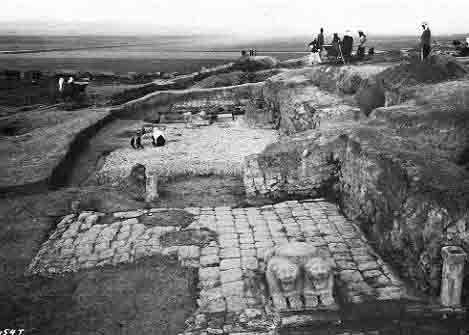Image Details

Oriental Institute, University of Chicago
Excavated in the 1930s by a team from the University of Chicago”s Oriental Institute, the eighth-century B.C. temple bore a remarkable resemblance to the 10th-century B.C. Temple of Solomon described in the Bible—evidence that the two temples shared a common architectural heritage.
Like the Solomonic Temple, the Tainat temple was a long-room temple divided into three sections: a portico, or porch, formed by the extension of the structure”s two long walls, enclosing two monumental pillars; a main hall; and a relatively small shrine area at the back of the main hall opposite the temple”s entrance (see drawing and plan).
The tripartite nature of the temple is clear from the plan and from the photo. In the foreground of the photo, a column base made up of two snarling lions, viewed from the east, is all that remains of the two monumental pillars that supported the portico roof. (See artist’s reconstruction.) Two Arab workmen, clothed in traditional garb, crouch on the pebbled floor of the temple”s main hall. Visible to the right of the workmen, at the back of the main hall, is the shrine area. Excavators at the top right of the photograph stand on the balk that separates the temple from the palace complex to the north of the temple.
Thanks to the discovery of the Tainat temple—and to subsequent discoveries of similar temples in Syria and Anatolia—archaeologists now believe that the long-room temple originated in northwestern Syria in the second millennium B.C.
